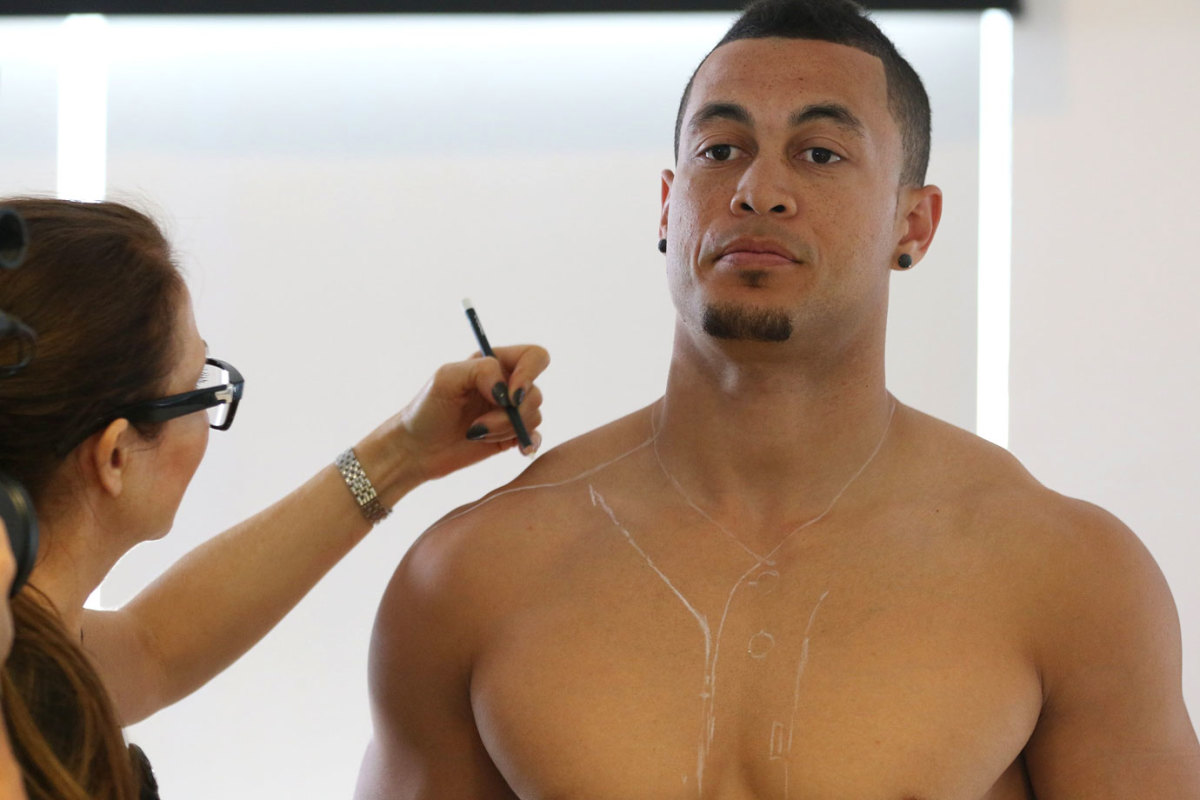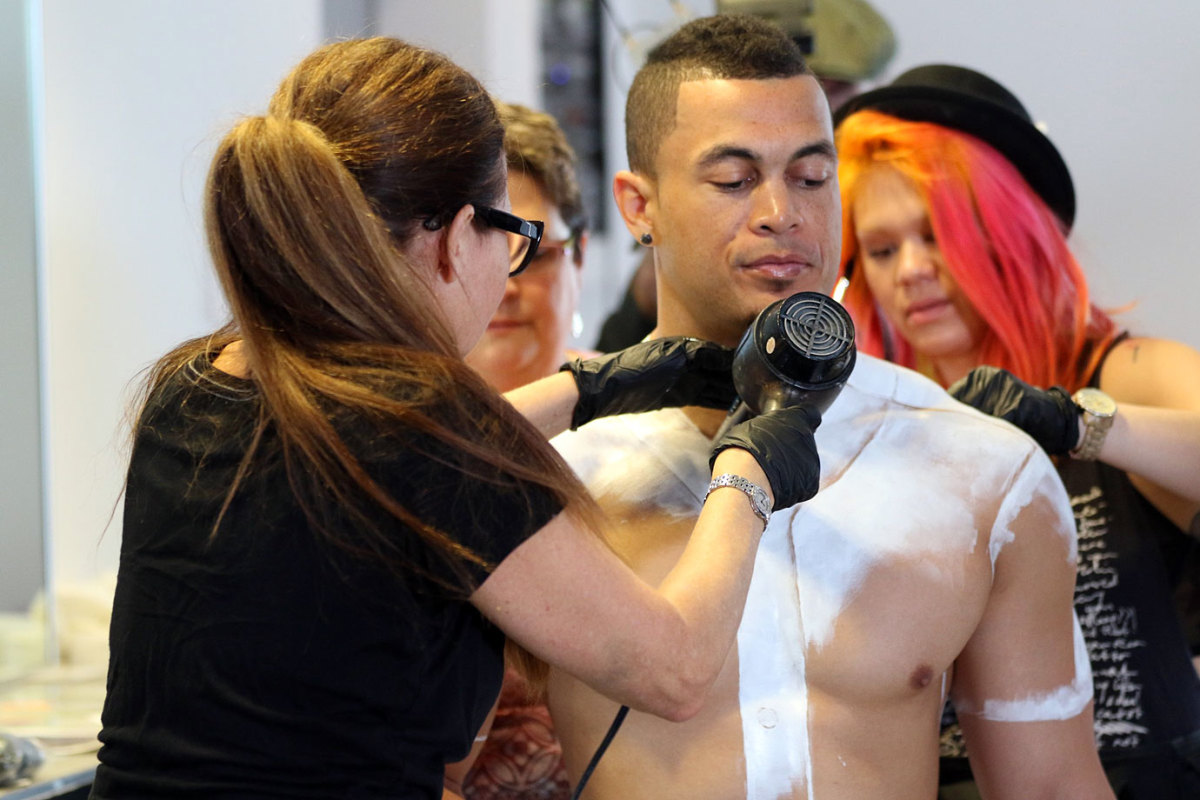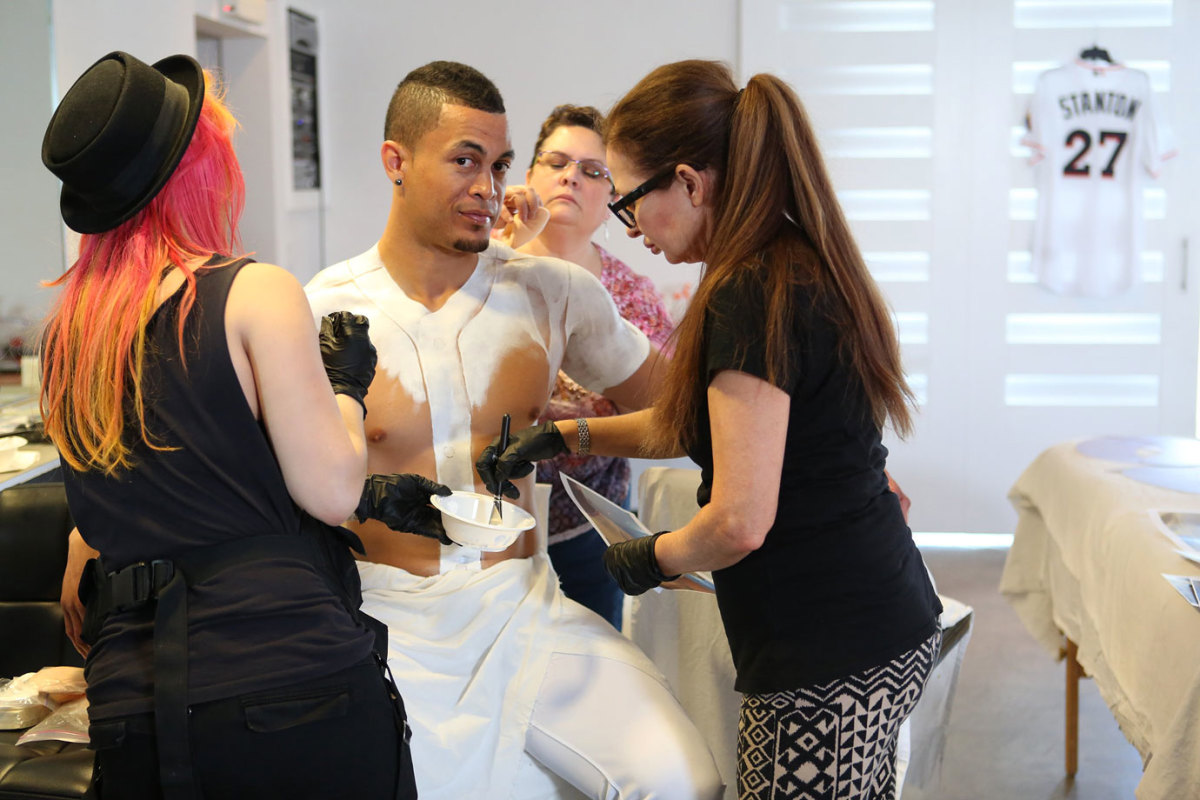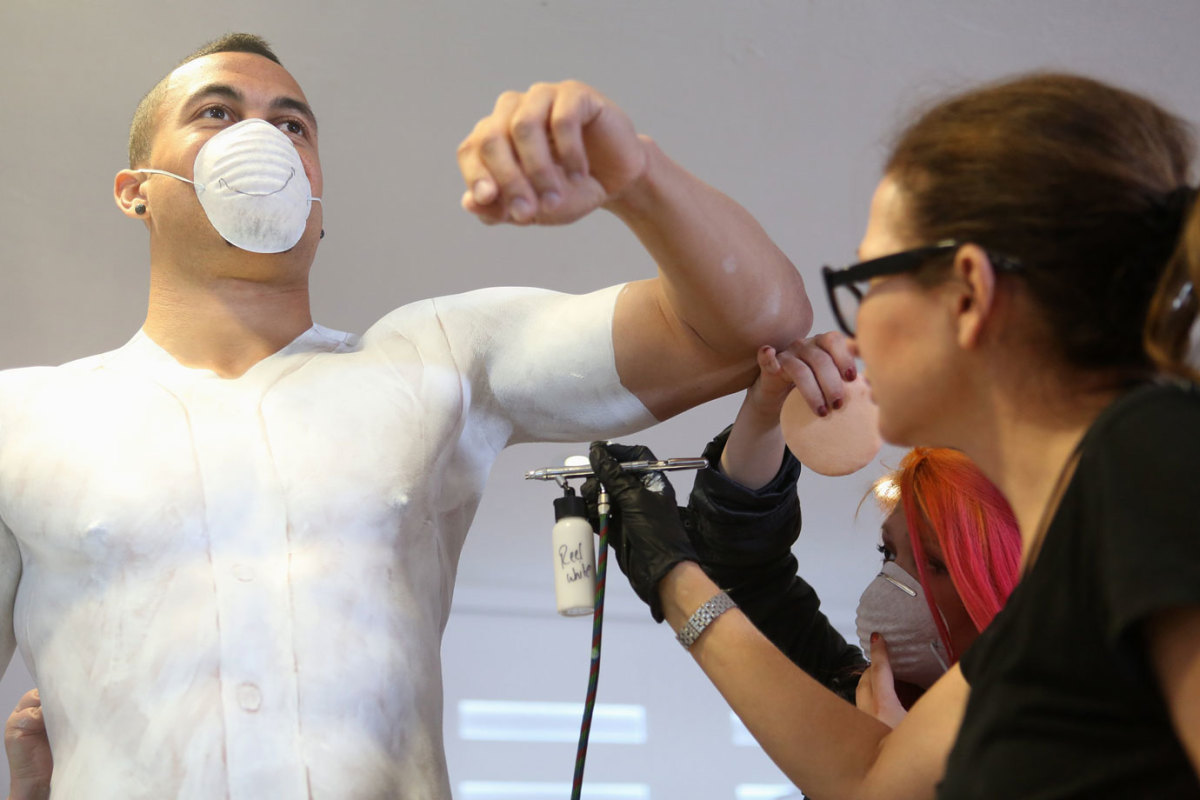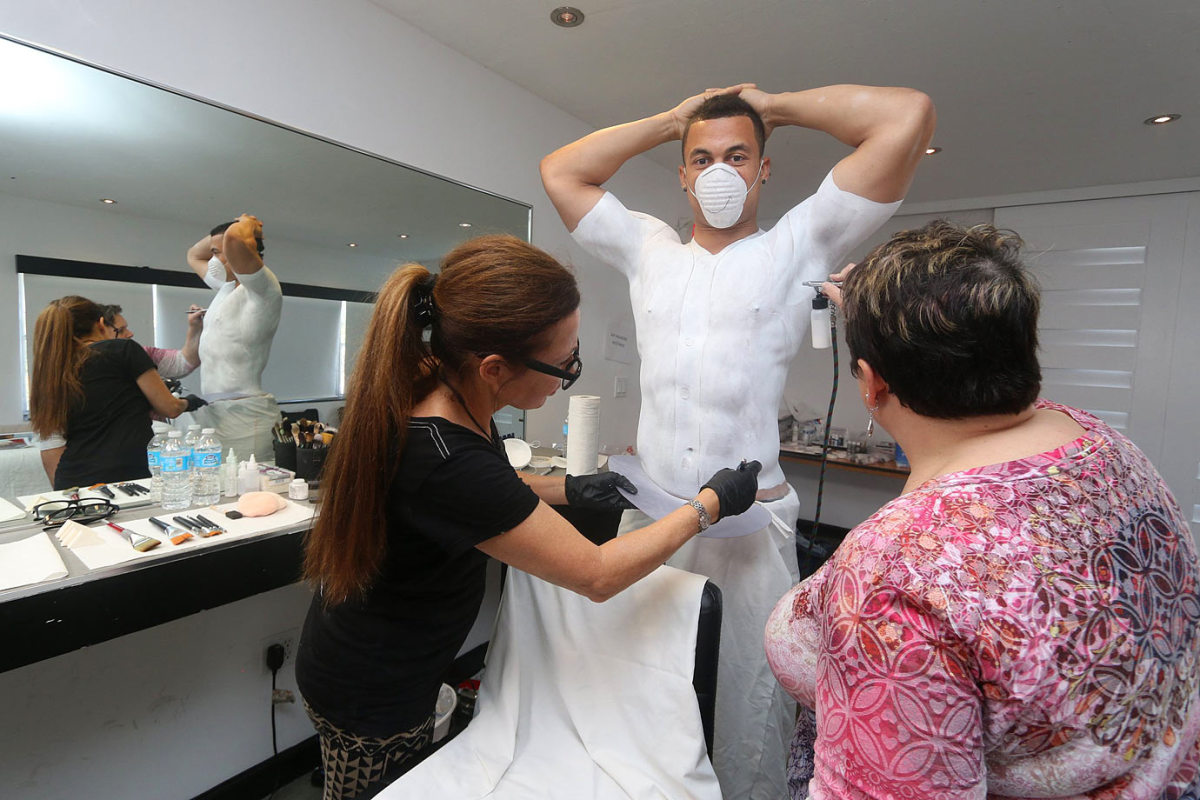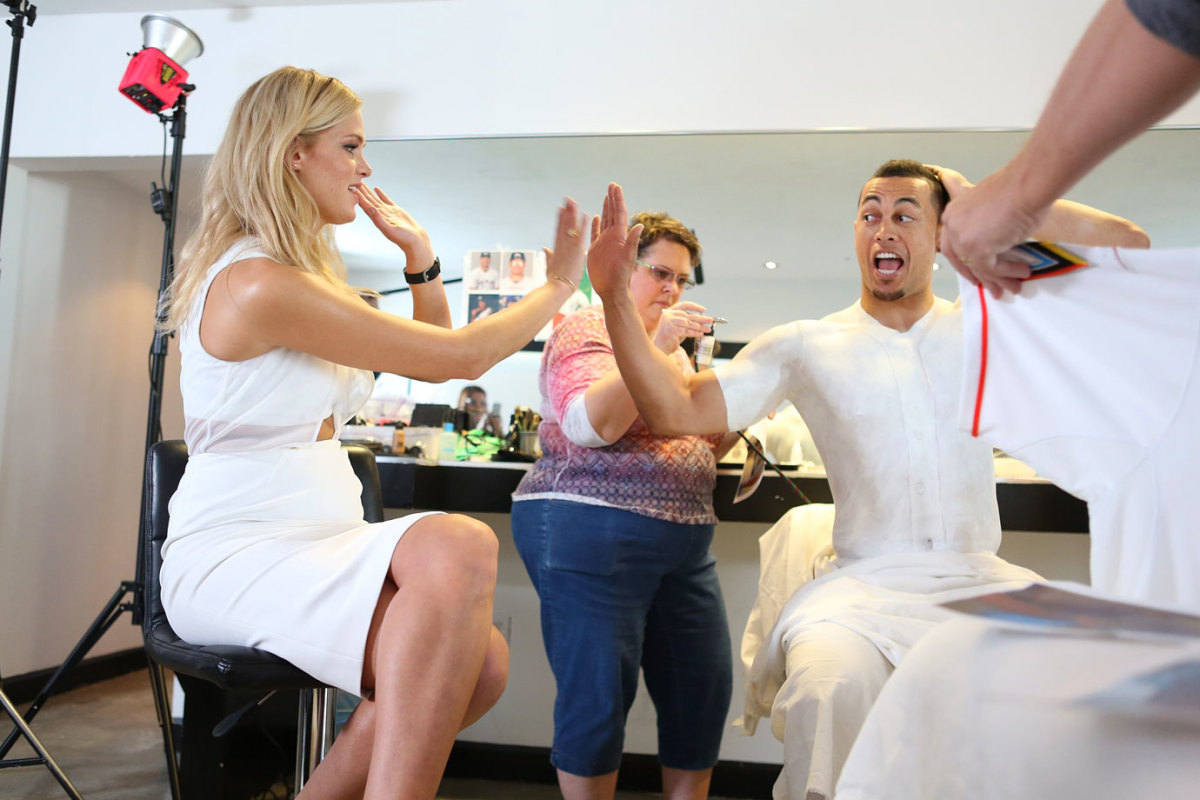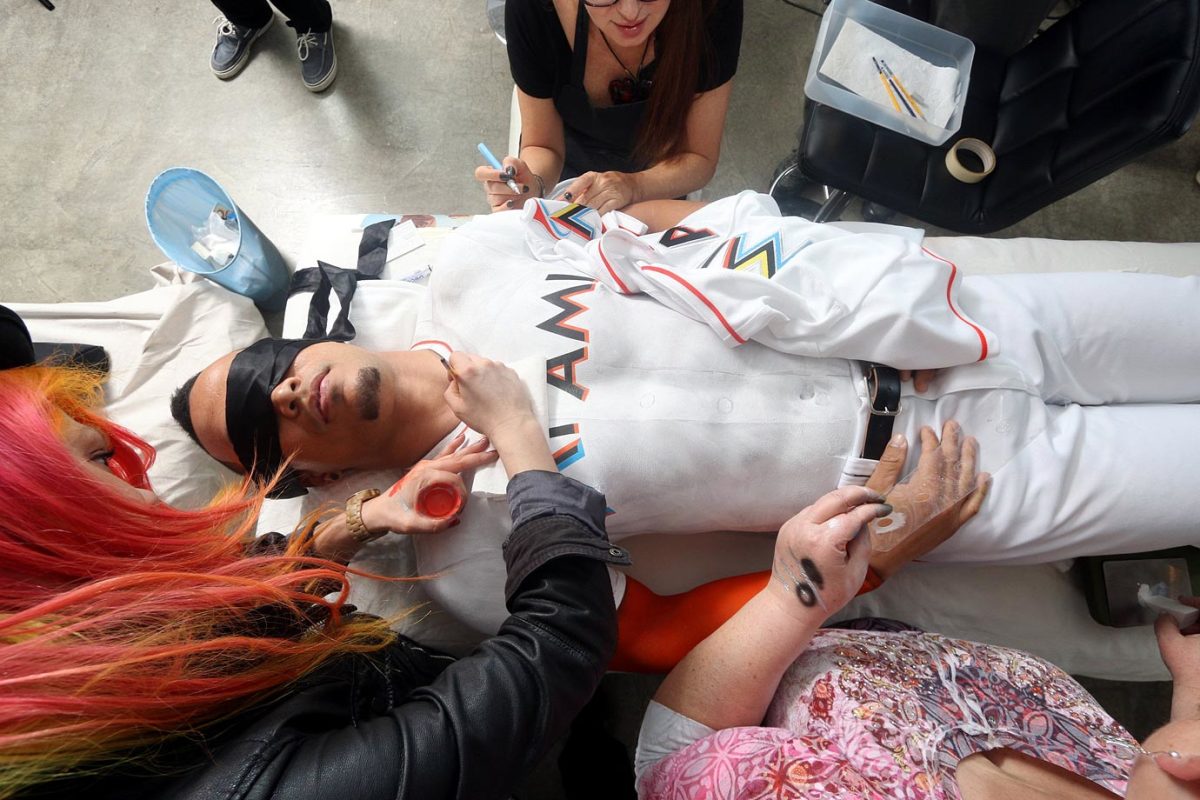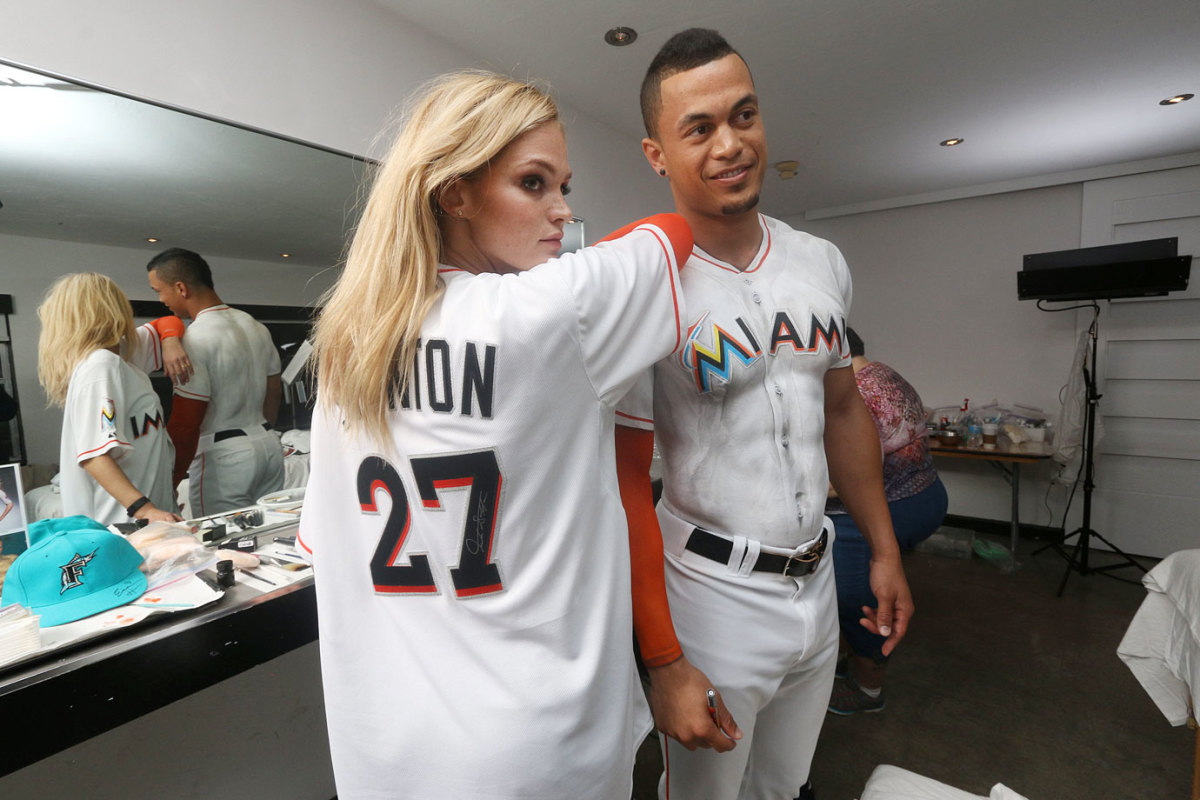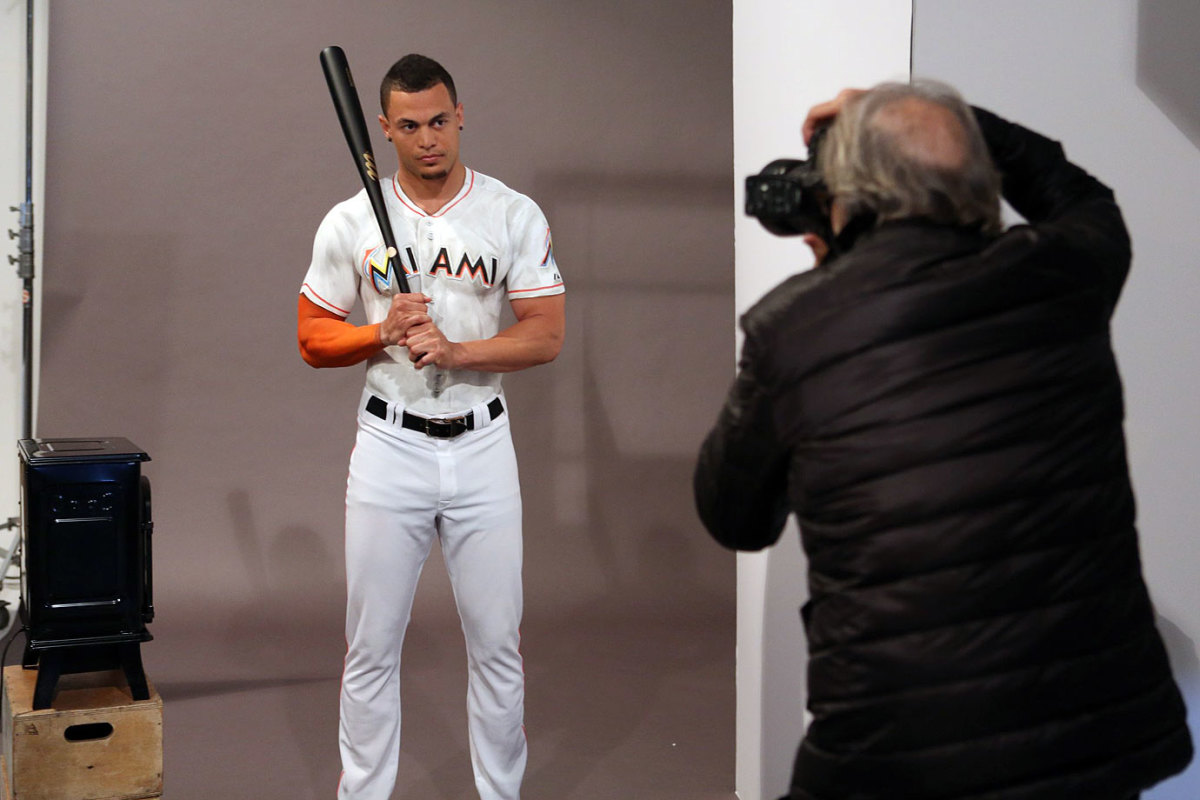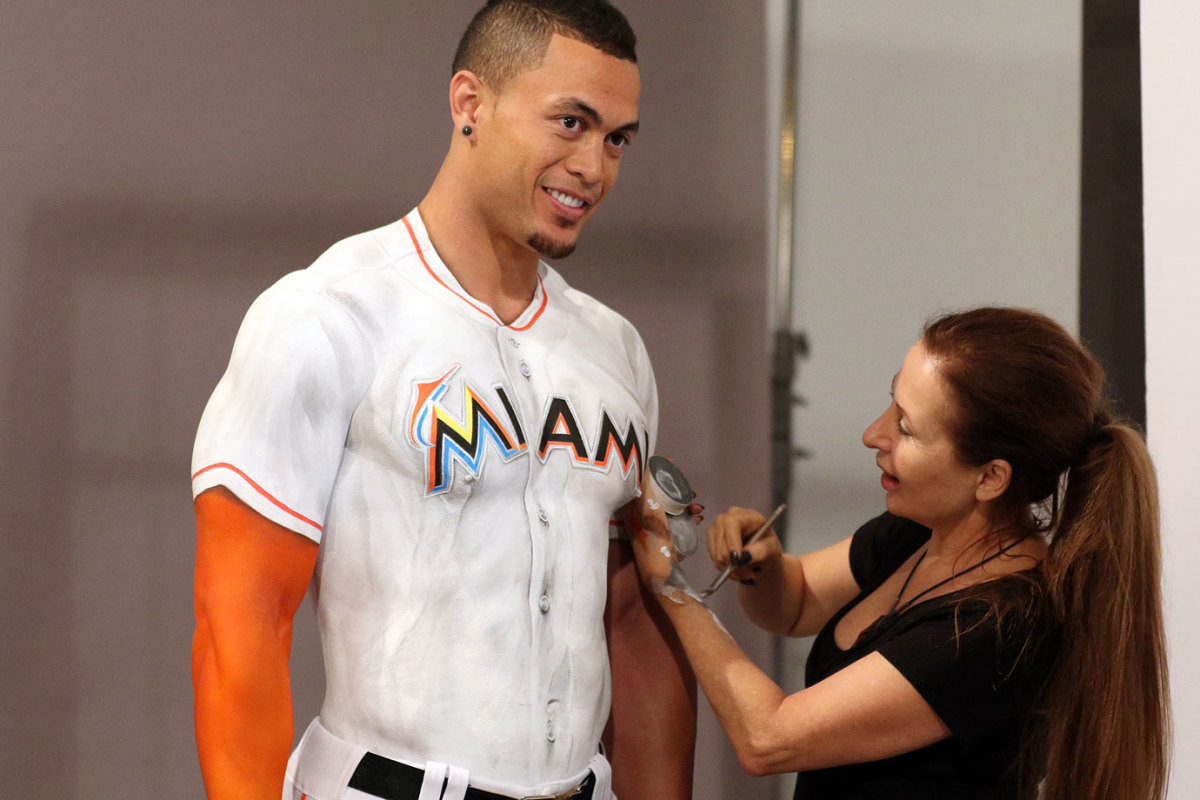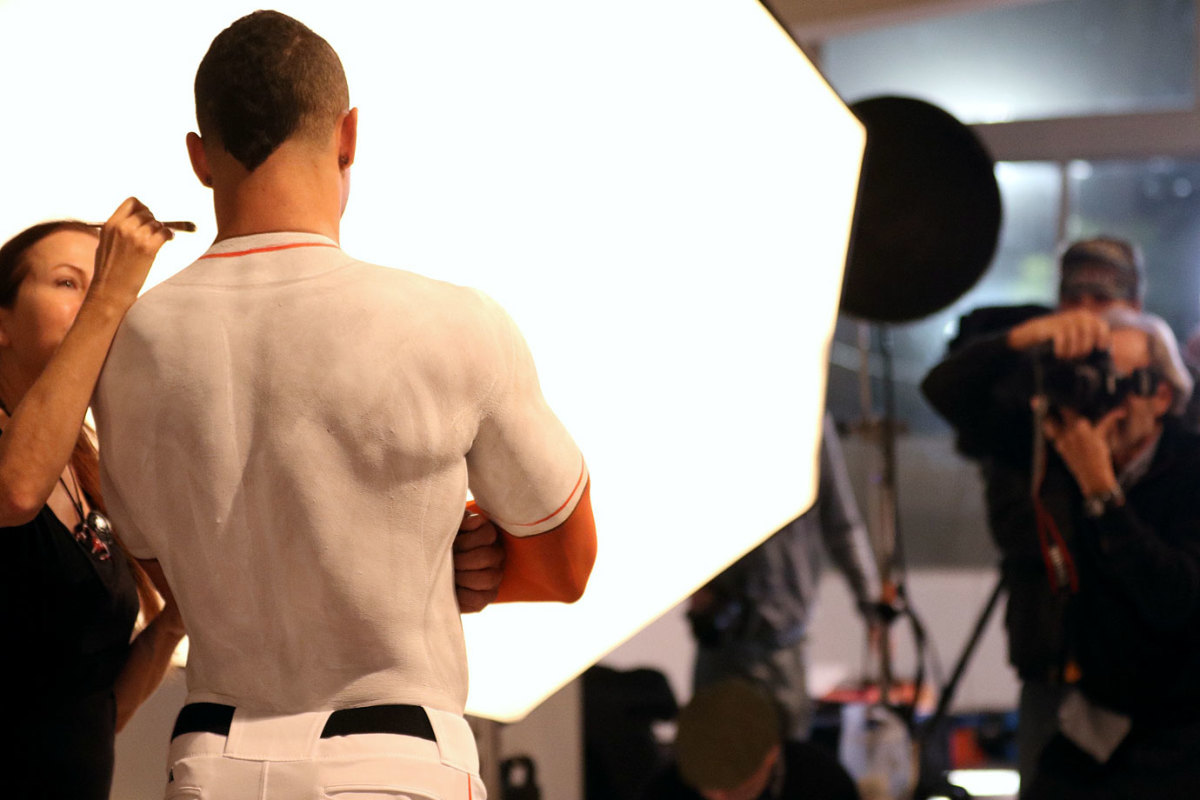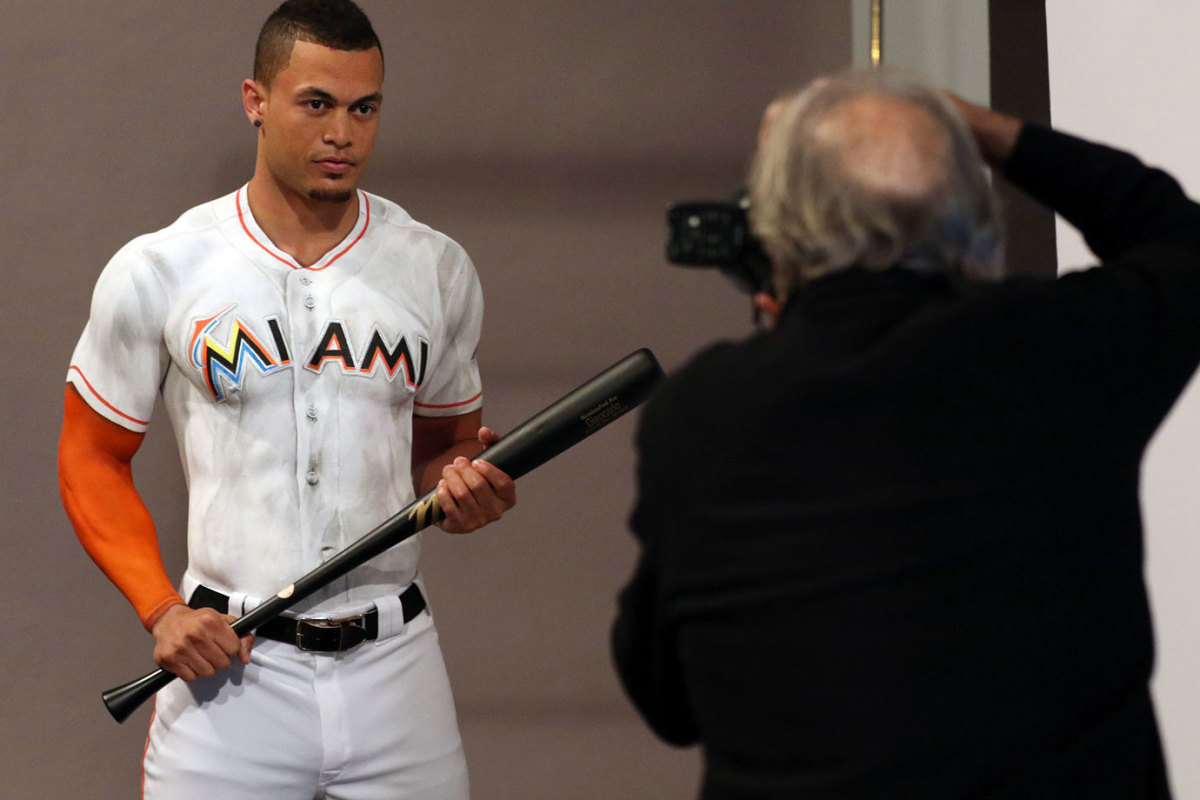Model slugger: Giancarlo Stanton is no paint-by-numbers superstar

This article appears in the March 2 edition of SI. To subscribe, click here.
They kept telling Giancarlo Stanton to roll onto his back, and he kept refusing, though since he couldn't speak he was unable to explain why. So as they tended to him on the steadily darkening dirt by home plate at Milwaukee's Miller Park, and as they loaded his 6'6", 240-pound body onto a stretcher to cart him off the field, and as they waited in the tunnel for the ambulance that seemed to take forever to arrive, and as the ambulance sped through the night, he remained on his left side. Stanton thought that if he did as they said, he might choke to death on the blood that was flooding his sinuses and gushing down his throat.
Everyone who was there on Sept. 11 remembers the sickening sound that Brewers pitcher Mike Fiers's 88‑mph fastball made when it struck Stanton's face, breaking his nose, his cheek and his orbital bone, shattering an incisor and chipping a half-dozen other teeth. They also remember the blood. "It was not just a little bit of blood," says Mike Redmond, the Marlins' manager. "It was a lot of blood."
Stanton's memory of those first few minutes is choppy. Fiers swings his left arm. Stanton sees the ball, but not until it is two-thirds of the way to the plate, far too late. He is on the ground, searching his gums for his teeth with his tongue and finding little pieces of them. He is in the ambulance, desperate to fall asleep to escape the pain, obeying the paramedics' instructions that he must not.
By the time he reached the hospital, Jeffrey Loria, the Marlins' owner, had already done what he could to ensure that his prized player would receive nothing but the best care. Says Loria, "Three seconds after I saw it on television and was able to pull myself together, I called the commissioner"—the Milwaukee-based Bud Selig—"and said, 'We need to get a plastic surgeon. This good-looking kid is not going to end up having a mistake made in an emergency room treatment.'"
The ER is where Stanton's memory returns in full. The doctor uses her finger to remove the six or seven shards of his teeth that were embedded in his lip, and then, from inside his mouth, pokes her finger through the hole that Fiers's pitch had ripped open in Stanton's cheek—"like a fish," Stanton says. His ears ring; his head pounds. The next day he flies home to Miami on a private jet arranged by Loria—at low altitude, as a normal flight path would have been too dangerous given the blood in his sinuses.
You might think that such a turn of events would have represented a traumatic, or at least an enduringly difficult, experience for Stanton, not least because it abruptly ended a season in which he, at age 24, slugged 37 homers, drove in 105 runs and would likely have won the National League's MVP award. (He ended up finishing second.) But he insists that he considers himself lucky. If Fiers's wayward pitch had hit him an inch lower, it would probably have broken his jaw. If it had hit him an inch higher, he might have been blinded. "I'm used to squaring balls up, so I squared it up as good as I could on that one—with my face," he says.
As for an off-season during which he had to undergo laser treatments for his scar, which is now imperceptible, and six dental procedures that have left him with a bite that still feels misaligned? "I'm not happy that I have to go through all this crap," he says. "But what can you do? Are you going to cry about it all day or just handle what you need to?"
For Giancarlo Stanton, receiving a fastball with his face proved a relatively fleeting, if very painful, annoyance. What happened two months later, when he signed over the next 13 years of his life to the Marlins—a franchise that has not made the playoffs in 12 seasons and is considered in many quarters to be baseball's most cynically run—and guaranteed himself more money, $325 million, than any other American athlete has earned on a single contract? That was hard.
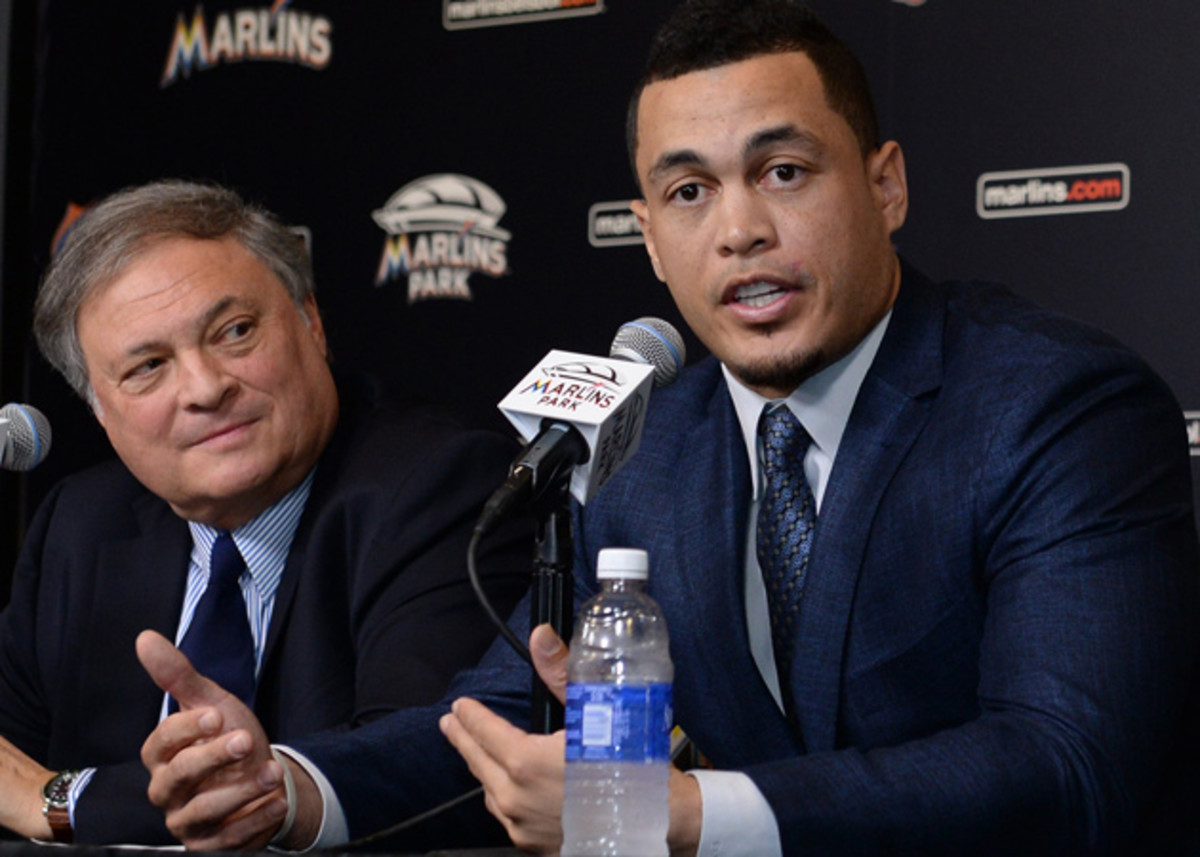
He knows no one understands it. Someone wants to give you $325 million? Three. Hundred. Twenty. Five. Million? To play baseball? When you grew up the son of postal workers? And there's a chance—even a chance—that you'll turn them down?
"There was no asking anyone for advice," Stanton says. "Because if you ask anyone, as soon as you tell them the dollars, they're like, 'What's the problem? Hell yeah, why don't you do it?'"
Stanton and his agent, Joel Wolfe, met with the Marlins' brass in Bungalow 10A of the Beverly Hills Hotel on Nov. 6 in Stanton's native L.A. Early in the meeting, club president David Samson—who was representing the team along with Loria, Redmond, president of baseball operations Mike Hill and GM Dan Jennings—slid a piece of paper over to Stanton printed with the outline of contractual terms that were unprecedented in both length and value.
"I think they were thinking I was going to be like, 'Oh, well, sign me up!'" Stanton says. He wasn't.
"I put the paper down, and I was like, 'I'll tell you right now that numbers don't mean anything,'" Stanton recalls. "'If you think you're just going to pay me a bunch of money, and I'm going to go live my lavish lifestyle, come to the park and get my ass kicked every day, and go back to my lavish lifestyle, you got another thing coming.' I said that straight to their faces. I was angered."
In his first five seasons, through age 24, Stanton hit more home runs, 154, than all but nine other players at that age. Six of them are Hall of Famers. The other three are Alex Rodriguez, Ken Griffey Jr. and Albert Pujols. If Stanton was in it for the money alone, he might have easily settled in as a one-dimensional slugger and earned loads of it. But he was driven by something else: a desire to wring everything he could out of his gifted body. So he has pushed himself to become an all-around force, an increasingly accomplished contact hitter (he finished last season batting .288, after flirting with .300 for much of the summer), an improving rightfielder and a solid base runner, too, as he swiped a career-high 13 bags on 14 attempts last year. "The slider tends to be the thing that gets him out, but he's beginning to recognize that more," says Stan Meek, the Marlins' longtime scouting director. "What Stanton has done is really work hard at the weaker part of his game. Even as a young kid, when he was playing in low A ball, they were in awe of his raw power, and it actually seemed like it was a little bit embarrassing to him. I think what he wanted to do more than anything was not just be known as a big, strong guy who can hit a ball a mile, but to become a complete baseball player."
• MORE MLB: Handing out final winter grades for each NL team
Stanton arrived in the majors in 2010, and his development led the Marlins, who had never before viewed anyone as untouchable (they once dealt away Miguel Cabrera, after all), to insist to disbelieving suitors that they would never trade him. By last year, says Samson, "We had sort of had an epiphany that this was the time to approach Giancarlo and discuss with him the possibility of being the man—and being the man forever."
The thing was, heading into this off-season Stanton had made clear that it would take more than money to make him the Marlins' man. He had already earned more than $7.4 million, and would likely have commanded nearly $40 million over his final two years of arbitration. After the 2016 season he could have become a free agent and gone to play for whoever he wanted—perhaps even his hometown Dodgers. What the Marlins had to do was to persuade a player who had, for a decade, taken complete control of his own life to surrender his destiny to them.
Compounding the issue was that Stanton's relationship with his front office had been periodically fraught. In late August, 2 1/2 weeks before he was hit by Fiers's pitch, Stanton was asked if the Marlins' modest success in 2014 (they had climbed to .500, just three games out of a wild-card spot) had done anything to erase the losing and the perceived broken promises he had so far experienced in Miami. "Five months," Stanton said ominously, "doesn't change five years."
Three months later Stanton was being introduced at a press conference as a Marlin for life. Something had changed, and it was more than his bank account and the contours of the left side of his face.
[pagebreak]
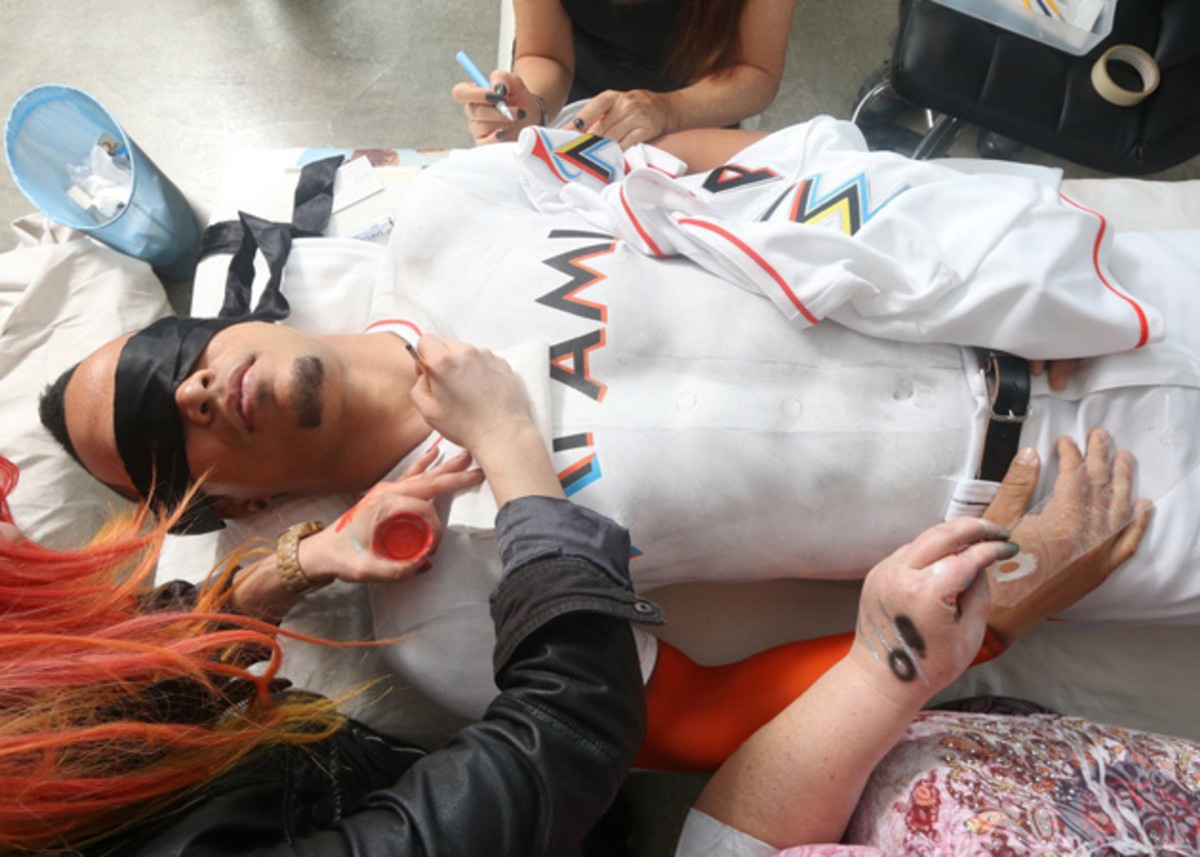
A visiting New Yorker who has been invited to visit Stanton this off-season in Los Angeles might discover via Google Maps that Stanton's house is located just seven-tenths of a mile from the visitor's hotel on the Sunset Strip. He might decide to walk. It will quickly prove a miscalculation.
As it turns out, the route runs entirely up a very steep hill. There are no sidewalks, and there are no streetlights, and on this evening there are plenty of sports cars negotiating the dark and winding road's blind curves at breakneck speeds. When the New Yorker dives into roadside bushes to avoid those, he will realize he is not alone. He will hear a rustling next to him—not of leaves, but of full branches, as might be produced by a midsized predatory mammal.
When the New Yorker, perspiring and jittery, finally reaches his destination, he will encounter a high gate with a buzzer next to it. The gate will slowly swing open, and there, standing by the front door in gym shorts and a sweat-stained T-shirt, will be Stanton, his mass backlit by the house's lights. "You walked?" he will say, incredulously. He is an Angeleno; he knows better.
The house is modern, stone and metal, with enormous artworks covering the walls and expansive views of Los Angeles, all the way to the Pacific, through its many windows and from its many balconies. It has a screening room, a hot tub and a putting green. It is precisely the type of place you would expect baseball's highest-paid player to live, except for a few things. One is that Stanton does not own it—nor any property, for that matter—and instead rents it on a month-to-month basis. Another is that he has housemates, A.J. Ramos (a Marlins reliever) and Ricky Nolasco (a former Marlins starter and current member of the Twins), who are among his best friends. A third is that the housemates clean the house, which appears spotless, themselves. Before they had friends over for a New Year's Eve party, baseball's highest-paid player spent an hour and a half washing the silver travertine floors. "His mopping game? Terrible," says Nolasco. "It's not like his baseball game."
It is tempting to look at Stanton's powerful yet lithe physique and imagine that it carried him smoothly from the San Fernando Valley to this life: spending the off-season in a fancy house on a hill with his buddies, a Maserati in the driveway, after a three-week tour of Europe. (This October, as he was still recovering from his injuries, Stanton traveled with Nolasco and Ramos to Spain, Romania, the Netherlands, France and Turkey.) He has always been big and strong. "As a real young kid, he was always built kind of square," says his father, Mike. Until 2012, Stanton went by his father's name—one of his middle names is Michael—though some members of his family called him Cruz, his other middle name. The full name reflects his mix of heritages; his father is of Irish descent and his mother is part black and part Puerto Rican.
The past 10 years have amounted to a graduated process in which Stanton relentlessly focused on maximizing his body's potential, and it has not always been easy. Eleven years ago Stanton was a freshman at Verdugo Hills High School, struggling with his parents' divorce, staying up all night, barely maintaining a 2.0 grade point average. His physical gifts separated him in football and basketball as well as baseball, but he lacked the structure to be serious about any of them.
As a sophomore, Stanton vowed to himself that something had to change. A friend attended Notre Dame High School in Sherman Oaks, a prestigious private school whose sports teams were good enough to play on TV, and Stanton decided that he wanted to go there too. Sophomore year he raised his grades enough to be accepted.
At Notre Dame, Stanton discovered that being built kind of square wasn't by itself nearly enough to succeed in baseball and that he had developmentally fallen behind many of the top-rated players in California, like Chatsworth's Mike Moustakas and Matt Dominguez and Cypress's Josh Vitters. They were destined to be first-round draft picks; as a junior, Stanton barely hit .200 and batted no higher than sixth or seventh in the lineup. So he set out to change that too—motivated not by the Range Rovers his classmates parked next to his 1999 Corolla ("They didn't work for that, so I didn't have envy") but by a desire to show that he ought to be on prospect magazine covers, right next to Moustakas and Dominguez and Vitters.
• MORE MLB: The veteran outfielder searching for one final big league shot
Nearly every day early that summer, he worked in the batting cage with a local hitting instructor named Phil Van Horn. At first he hardly made any contact, so quickly did he yank his bat's head through the zone. Then he started making contact, but he couldn't hit anything fair. Then he started hitting balls fair, but only if they were fastballs. Then he started hitting most everything, and hitting it far.
Nobody in California emerges from nowhere like that, so most pro scouts couldn't bring themselves to believe what they were seeing. One did: Tim McDonnell, who was in his first year on the Marlins' staff. "I saw this big fella hitting balls as far as Jose Canseco once did," McDonnell recalls.
The Marlins attended every one of Stanton's games when he was a senior. Their scouts tried to maintain a low profile to conceal their interest from other clubs, although it often was not necessary. "We're hiding at every game, but a lot of times we're the only guys there," says McDonnell.
McDonnell's reports helped persuade Meek and the rest of the front office to pick the relative unknown with the big stick in the second round of the 2007 draft. Seventy-five players had gone ahead of him, and the Marlins had taken Dominguez 12th overall. "I went out to Los Angeles to see the two young men we had drafted," recalls Loria. "I walked on the field, and I saw this sculptured, athletic, wonderful-looking young man. I said, If the physical presence is anything, we have a winner here."
It soon became clear that they did. Stanton crushed 39 home runs as an 18-year-old in A ball in 2008. Two years later, at 20, he hit 22 in 100 games as a rookie Marlin. Four years after that—just eight summers after he had batted .200 as a high school junior—he was headed for the NL MVP award, at least until his unfortunate meeting with Mike Fiers's fastball. He had turned himself into a franchise player, perhaps even a once-in-a-generation talent. But as the Marlins discovered in that hotel room in Beverly Hills in November, a once-in-a-generation contract was only part of what it would take to make him theirs long-term.
[pagebreak]
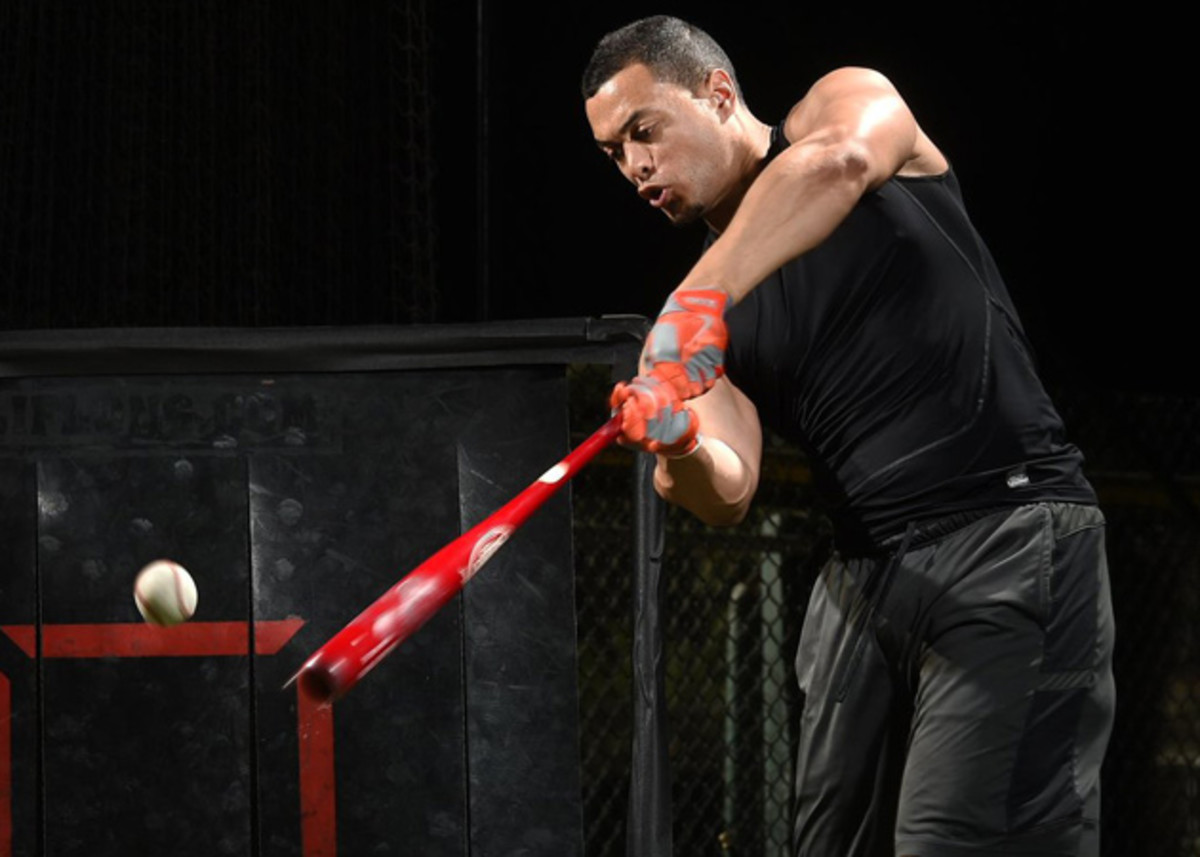
After Stanton looked at the contract offer that the Marlins hoped would blow him away, he expressed the frustrations that had accumulated during his five years in Miami: the talented teammates that had been traded; the false promise of 2012, when the front office opened the new Marlins Park with a payroll in excess of $100 million, only to hack it by more than half the following season. "You guys can do this for 20, 30 years," Stanton told them. "I have only a relatively tiny gap of being at my best, in my prime. And I want to make a difference during that time."
The Marlins, for their part, admitted their errors. They said they realized that their attempt at instant contention in '12, behind the free-agent signings of Heath Bell, Mark Buehrle and Jose Reyes, had been ill-conceived, but that since then they had been assiduously constructing a foundation for sustained success—with Stanton as the cornerstone. "I know that people haven't always agreed with the moves I've made as an owner," says Loria. "But I've been very consistent in what I set out to do, since 2012 and '13, which is hit the reset button and create a long-term system around which we could build a long-term winner." Of Stanton's past complaints about his tactics, most notably in the wake of the 2012 trade that sent Reyes, Buehrle and other players to the Blue Jays, Loria says, "He did that because he was a little bit younger, had made some friends. That story was old history now."
Stanton, though he was gradually moving toward accepting the deal, still had his doubts. He hoped to sleep through the five hours of MRIs he had to undergo at the University of Miami hospital as part of his presigning physical, but he found himself lying awake in the machine's clicking tube. Did I miss anything? he wondered. Is this the right decision?
When he ultimately signed, on Nov. 19, he did so for three central reasons. One was that he genuinely loves his adopted hometown, which reminds him of the European cities he explores every winter. "I could go anywhere," he says, "but if we win here, I'd rather be here over any place, any other city."
The second was that he looks at the young players that the Marlins have assembled around him, and he believes in them: in Jose Fernandez, the 22-year-old ace who will return from Tommy John surgery at midseason; in his fellow outfielders Marcell Ozuna, 24, and Christian Yelich, 23; in Adeiny Hechavarria, the 25-year-old shortstop. "Never are we going to be the biggest market, have the highest payroll, none of that," Stanton says. "And the players that we have, they're still not the biggest names, most people aren't going to know who they are. But in terms of pure talent, they're there." Stanton agreed to backload his contract—he will make less than $15 million in each of its first three years, and over $25 million in each of the remaining ones—to allow the Marlins to sign some of his contemporaries to their own long-term deals.
• MORE MLB: Big spring questions, camp battles, prospects for NL East
The third reason was that he believed Loria's days of rebooting his franchise were over, and the best proof was Stanton's own $325 million offer. "Why would you give me so much money and not try to win?" Stanton asks. "What on earth is the point of that? They have to be serious about winning going forward. There's no other logical explanation."
Even so, Stanton demanded insurance, in the form of an opt-out clause that allows him to escape the contract after the 2020 season, when the team will have paid him $107 million and he will only be 30. "We did not want an opt out," says Samson. "We wanted him for the full 13 years, and we are viewing this as a 13-year commitment. He assured us that it had nothing to do with money, or trying after six years to get more of it. We realized he's not using the opt out as a sword, he's using it as a shield."
"That was make or break for me," Stanton explains. "Because of how things have gone the previous five years. I just wasn't ready to let that happen for 13 more. I do have to trust that they're going to do what we plan to do over the next six years. But if they're not going to, then..."
For the Marlins, who departed from team policy by acceding to Stanton's demand for a no-trade clause, there is no fail-safe. If Stanton suffers a catastrophic injury, or if his production inexplicably wanes, then they will be on the hook for one of sports's greatest contractual missteps.
"I would say that me, Mike Hill and Dan Jennings have obviously put our careers and jobs on the line," says Samson. "Our view is that the risk is de minimis. Because the quality of player and person he is leads to our belief that he will continue to get better, and that we haven't even seen him at his best."
"There are no considerations for another reset," says the 74-year-old Loria. "None. I haven't even thought about it."
Shortly after signing Stanton, the Marlins set about implementing their new strategy, which involves surrounding him and the other members of their young core with established veterans on shorter deals. They included starters Mat Latos and Dan Haren (who will become free agents after this year), third baseman Martin Prado, and first baseman Michael Morse and second baseman Dee Gordon. Such players, while talented, are always replaceable down the road. A player like Stanton is not. "You're fortunate enough to have a great player, what's the point of not keeping him?" asks Loria. "If he's not playing baseball for us, I might as well be doing something else, and I don't want to be doing something else."
Stanton's emotions upon signing the deal surprised him. "I thought it'd be different," he says. "Kind of like, a lot of weight lifted off of my shoulders, as I don't have to worry about finances for the rest of my life, or my family's. But it wasn't like that. It was more—there's things I need to get done."
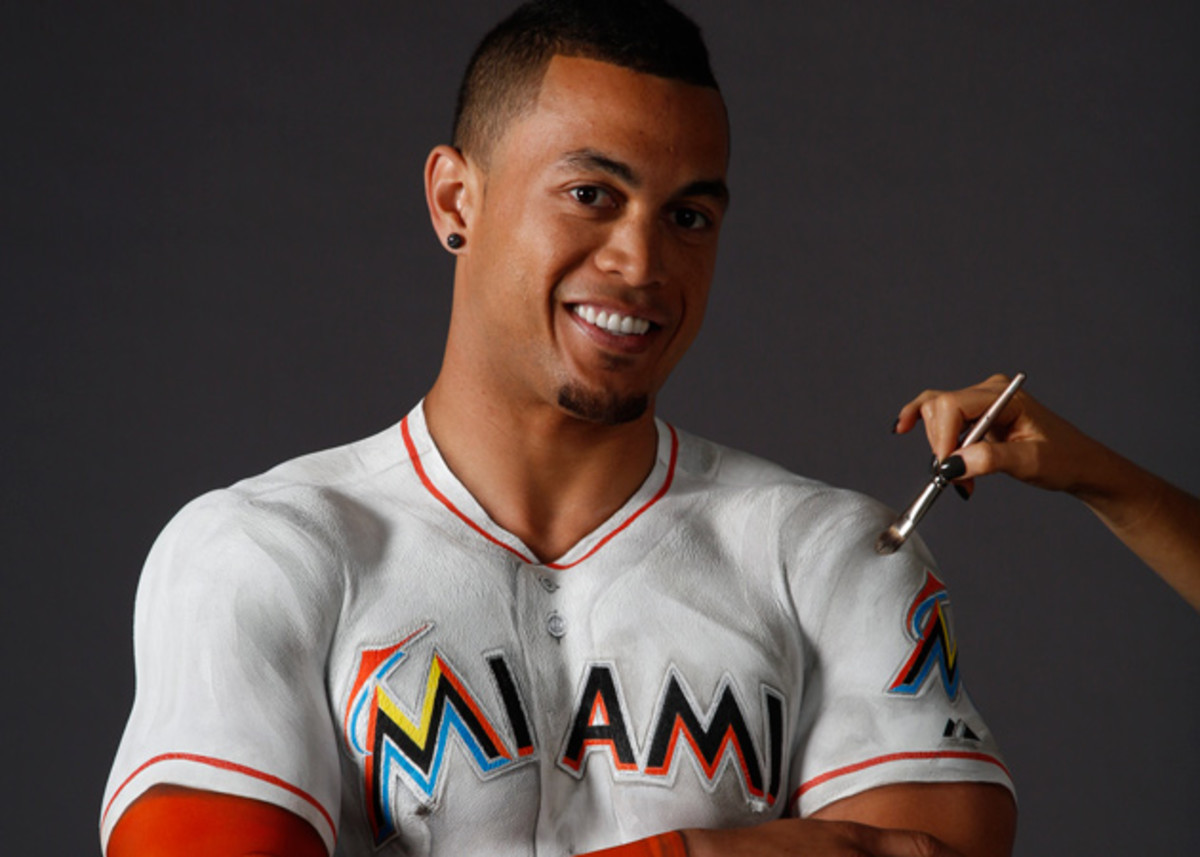
When he wasn't in the dentist's chair, or signing a contract that will make him part of the wealthiest .01% in the United States, Stanton did manage to have some fun this winter. There was his tour of Europe, where the locals all thought he was a visiting Brazilian soccer player. There were plenty of late nights with Nolasco and Ramos in Hollywood. (Stanton is single.) In late January he served as a judge, along with demi-celebrities such as Lisa Vanderpump and Emilio Estefan, at the Miss Universe pageant. "What's the biggest change you'd like to see for young women in the next generation?" he asked Miss Netherlands.
Mostly, though, he endeavored to make this off-season as normal as possible. Normal, for Stanton, meant working out eight times a week with the husband-and-wife training team of Tarrik and Kanika Brock at locations around L.A., from the Santa Monica dunes to a private gym in West Hollywood, where he lifts next to actors Kevin Connolly and Dolph Lundgren and maxes out the available dumbbells, benching 110 pounds in each hand. (Connolly and Lundgren do not.)
One day in January, Stanton, Nolasco and Ramos drove out to Drake Stadium, home of the UCLA track team. While the Bruins' runners circled round and round, Stanton strapped a 60-pound weight vest onto his bare shoulders and, following the Brocks' instructions, began to sprint up and down the steps of the stadium's stands. There were 15 columns of 80 steps each, and Stanton—with Ramos right behind him, and Nolasco, after a while, some distance back—made his way all the way to the stands' far end and then returned, for a total of 2,400 steps without a break. "Most baseball players, let's face it, they go 90 feet," said Kanika, an experienced track athlete and trainer. "They're not going to train hard like this."
When he was finished—it was a warmup—Stanton was drenched with sweat and his diaphragm vibrated. He could not speak for nearly five minutes. "You gotta go until you're completely fatigued, so you know what breaks first, what gets weak first," he said finally. "I always keep an eye on where I was when I felt like I needed to stop, and had to force myself to push through. For me, it's always early, maybe a quarter of the way. How am I going to do three times more than what I just did? But then you just find another gear."
That his unique combination of gifts and drive brought with it an unprecedented contract—and a new identity as the game's highest-paid player—is, to Stanton, almost coincidental. "What everybody's doing is asking, if I go take a two-hour nap, how much money am I making during that nap?" he says. (The answer: something like $5,700.) "But what can I do? It's not like I held a gun to their head and said, 'Give me this money.' If the person asking the question was offered something like that, what would they do?" Stanton plans to buy new homes for his father and his mother, and to become charitably active in both Los Angeles and Miami, but so far he has made no major purchases for himself. "Some food, I guess? I don't know."
Sometimes Stanton envisions where he will be 13 years from now, when the contract will expire, if all goes well. "I'll be 37, 38," he says. "That's over half the years I've already lived from now. I'll be completely different at that point. Maturity, perspectives. Family, possibly, you never know what's going to happen. Just have to see how it's going to work—how I'm going to make it work."
The first spring training of the rest of his life was looming, and it would include the first live pitch he's seen since Mike Fiers's. Of how he will react to that, Stanton says, "I'm not going to fully know until I'm in the game. But it's all about the thought process. The more I'm going to let it bother me, the less success I'm going to have. Which one do you want—are you going to be scared, or are you going to be successful?"
There were still more steps to climb.
Behind the scenes of Giancarlo Stanton's bodypainting
